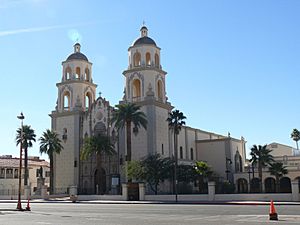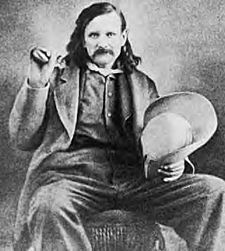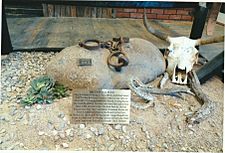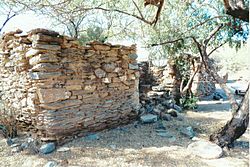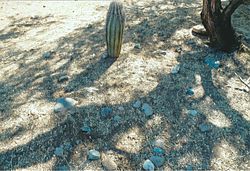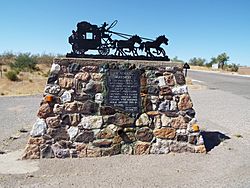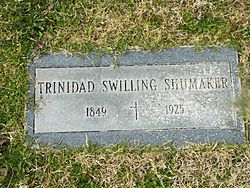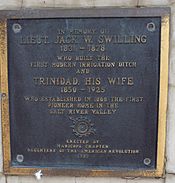Trinidad Swilling facts for kids
Quick facts for kids
Trinidad Swilling
|
|
|---|---|

Trinidad Escalante Swilling-Schumaker
"Mother of Phoenix, Arizona" |
|
| Born |
Trinidad Mejia Escalante
April 15, 1849 |
| Died | December 27, 1925 |
| Occupation | Housewife, seamstress |
| Known for | "The "Mother of Phoenix" |
| Spouse(s) | Jack Swilling 1864–1878 Henry Schumaker 1887–1896 |
| Parent(s) | Ignatus Mejia and Petra Escalante |
Trinidad Swilling Shumaker (April 15, 1849 – December 27, 1925) was a brave pioneer. She is known as "The Mother of Phoenix" in Phoenix, Arizona. She was the wife of Jack Swilling, who helped start Phoenix. Trinidad was active in her community. She also helped make sure her husband was remembered as the founder of Phoenix. She even had a friendly debate in the news about who was the first White woman to live in the Phoenix area. In 1868, Mrs. Swilling created the first pioneer home in the Salt River Valley.
Contents
Early Life in Mexico and Arizona
Trinidad Mejia Escalante was born on April 15, 1849. Her birthplace was Hermosillo, Mexico. This city is in the northwestern state of Sonora. Her father was Ignatus Mejia. Her mother was Petra Escalante. Trinidad's grandfather was from Spain. He moved to Mexico a long time ago.
Arizona used to be part of Mexico. This changed after the Mexican–American War in 1848. The Treaty of Guadalupe Hidalgo and the 1853 Gadsden Purchase set the new border. Mexicans living in the new U.S. territory became American citizens. This included Trinidad's relatives in Tucson.
In 1864, Trinidad's father passed away. She and her mother moved to Tucson, in the Territory of Arizona. They wanted to be with their family. Trinidad was 15 years old at that time.
Marriage to Jack Swilling
When Trinidad was 17, she met John William Swilling. Most people knew him as Jack Swilling. He was visiting Tucson. Jack was from Anderson, South Carolina. Before meeting Trinidad, he was a soldier. He was part of a group called the Arizona Guards. This group protected early settlers from attacks.
Jack Swilling also looked for gold. He became friends with King Woolsey. Jack went to Tucson to buy flour for Woolsey. But the mill he partly owned had no flour. He had to wait for a shipment from Hermosillo.
When Jack first saw Trinidad, he told his friends he would marry her. They met and fell in love. They wanted to get married. But Trinidad's mother didn't approve. Jack was 34, and Trinidad was only 17. So, they decided to run away together. They lived together in Tucson. On April 11, 1864, they were married. Father Aloysius M. Bosco came to Tucson's St. Augustine's Cathedral. He would baptize children and marry Catholic couples. Jack and Trinidad were married then. It was common for men on the frontier to marry Mexican or Native American women.
Trinidad and Jack had seven children:
- Georgia (born 1865)
- Matilda (born 1867)
- Leila (Lilly) (born 1871)
- Elizabeth (born 1873)
- Berry (born 1874)
- Matilda Adeline (born 1876)
- John William Jr. (born 1878)
The Swillings moved to Yavapai County. They started a farm at Walnut Grove. They lived there for a year. Then they moved to Wickenburg. They started another farm near the Hassayampa River. Trinidad's mother, Mrs. Mejia, lived with them. She passed away in 1865. On November 11, 1867, Jack Swilling started the Swilling Irrigating and Canal Company in Wickenburg.
In 1867, the Swillings moved again. This time they went to the Salt River Valley. This is where Black Canyon City is today. Jack built a small "Rock House." Trinidad called it her "1st House." Trinidad said she was the first Mexican woman in the Phoenix area. She also said her friend, Mrs. Lough, was the first white woman there.
Founding the City of Phoenix
Jack Swilling's company, the Swilling Irrigating and Canal Company, had 16 investors. These included Phillip Darrell Duppa (also known as Lord Duppa). They dug a modern canal system. Mexican workers helped them. This canal brought water from the Salt River to farms. This area later became the city of Phoenix. The canal was called "Swilling's Ditch" and it worked very well. In 1884, the Joint Head Dam was built where Jack started his ditch.
The Swillings claimed 160 acres of land. This is now around 32nd Street and Van Buren in Phoenix. They started a farm with an orchard and a vineyard. The Swillings became very successful. They built a 10-room house. This house often served as a meeting place for the community. The first Catholic Mass in Phoenix was held in their home. A priest from Florence would travel by wagon to hold services there.
Jack Swilling wanted to start a new settlement. He wanted to call it "Pumpkinville." This would be near his mill. But people debated the name. Other names like "Stonewall" and "Salina" were suggested.
There was a big discussion about where the new town should be. One idea was around Swilling's farm. The other was about a mile west. A new group, the "Salt River Valley Town Association" (SRVTA), supported the western site. Because of money reasons for the SRVTA members, the western site was chosen. A 320-acre plot of land was bought. This is now the downtown area. Jack agreed with the decision to build the city at its current spot.
Many people believe Lord Duppa suggested the name Phoenix. This name comes from the mythical bird, the Phoenix. The bird is reborn from ashes. This idea fit because a new city of canals was being built. It was on the site of ancient canals made by the Hohokam people. These old canals were from about 700–1400 AD. Jack Swilling became the Justice of the Peace for Phoenix. He was also Phoenix's first postmaster. Because of this, Jack was called "the Father of Phoenix." And Trinidad was called "the Mother of Phoenix." In 1868, Trinidad started the first pioneer home in the Salt River Valley.
Jack Swilling's Later Years and Passing
Jack Swilling continued to search for gold in the Bradshaw Mountains. The family moved to Gillett. There, they owned several businesses. They had "Gillett Real Estate," selling land lots. They also had a cattle and horse ranch. And they had a vegetable farm with a partner. Later, the Swillings moved to Black Canyon City. They built a stone house and started a farm. Jack organized a group to build an irrigation ditch. This ditch brought water from the Aqua Fria River to their property. This helped him raise cattle. Their house became a popular stop for stagecoaches. Travelers from Prescott to Phoenix would rest there.
In the spring of 1878, the Swillings heard sad news. Colonel Jacob Snively, a family friend, had passed away. He was killed in the Wickenburg Mountains. Trinidad suggested that Jack and two friends go to find and rebury his remains.
On April 17, Jack and his friends went on the trip. They returned to Gillett on April 23. Jack was seen with a bag containing Colonel Snively's remains. Jack buried the bones on his property, near his house.
Around this time, a stagecoach was robbed near Wickenburg. Several people were killed. Jack and his friends were talking about the event in a bar. Jack jokingly said that he and his friends matched the description of the robbers. Because of this joke, Jack and his friends became suspects.
Sheriff Wiley W. Standefer arrested Jack Swilling and Andrew Kirby. They were taken to the Yuma Territorial Prison. The prison conditions were very bad. The heat and poor conditions made Jack's health worse. According to Trinidad, Jack was released from prison because he was so sick. He went to stay with the Hodges family, who were friends. He passed away at their home. Jack Swilling was buried in the Yuma Cemetery. Later, a headstone was placed on his grave. The real criminals were caught later. This proved Jack's innocence, but it was too late.
Trinidad as Mrs. Schumaker
After Jack Swilling passed away, Trinidad returned to Gillett for a few months. She then sold her properties there. In 1879, she moved to Phoenix. She was in a difficult financial situation after Jack's death. She was very poor when she arrived in Phoenix. She found work as a seamstress to support her children.
She met Henry Schumaker, who was from Germany. On September 28, 1887, she married him. After this, she was known as Mrs. Schumaker. They had three children together. Henry Schumaker passed away on March 11, 1896. He was buried in the City Loosley Cemetery. This cemetery is now part of the Pioneer and Military Memorial Park.
Mrs. Schumaker gave some special items to the Arizona Museum. She donated her mother's rosary, prayer book, and a lace shawl. She also gave the museum a rifle that belonged to Jack Swilling. His name was carved into it.
In her later years, Mrs. Schumaker was part of a public discussion. People debated who was the first white woman in Phoenix. Mrs. Schumaker said:
- "I was the first Mexican woman in Phoenix, and Mrs. Lough was the first white woman."
This discussion was in the local news. Many early settlers supported her. Phoenix newspapers wrote:
- "Mrs. Swilling was the first white woman to settle in the Salt River Valley."
One day, Mrs. Ethel Clark and Mrs. Schumaker were at the Park of the Four Waters. Mrs. Clark was in charge of historic spots for the Daughters of the American Revolution. They talked about Mrs. Clark moving the body of Charles Debrille Poston in 1925. He was moved from a cemetery in Phoenix to Poston's Butte in Florence, Arizona. Mrs. Schumaker then told Mrs. Clark:
- "I hope you will do something for my husband, Jack Swilling, who was the founder of Phoenix."
Mrs. Clark promised that her group would do something to remember Jack Swilling.
On December 27, 1925, Trinidad Swilling Schumaker passed away. She died at her home in Phoenix from liver cancer. Her funeral was held at Saint Mary's Basilica. She was buried in St. Francis Catholic Cemetery in Phoenix.
On February 19, 1931, a special ceremony took place. The Daughters of the American Revolution, along with Arizona Governor George W. P. Hunt, honored Jack and Trinidad Swilling. They unveiled a fountain in a park in front of the courthouse in Phoenix. The fountain has a small bronze plaque. It says:
- "In memory of Lieut. Jack W. Swilling, 1831–1878, who built the first modern irrigation ditch, and Trinidad, his wife, 1850–1925, who established in 1868 the first pioneer home in the Salt River Valley."
See also
- History of Phoenix, Arizona
- St. Francis Catholic Cemetery
- History of Arizona
- List of historic properties in Black Canyon City, Arizona
Arizona Pioneers
- Mansel Carter
- Bill Downing
- Henry Garfias
- Winston C. Hackett
- John C. Lincoln
- Paul W. Litchfield
- Joe Mayer
- William John Murphy
- Wing F. Ong
- Levi Ruggles
- Sedona Schnebly
- Michael Sullivan
- Ora Rush Weed
- Henry Wickenburg


